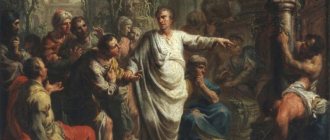Lexical means: tropes
Allegory - Themis (woman with scales) - justice. Replacement of an abstract concept with a concrete image.Hyperbola — Bloomers as wide as the Black Sea (N. Gogol) Artistic exaggeration.Irony - Where are you getting your head from, smart one? (Fable by I. Krylov). Subtle mockery, used in the opposite sense to the direct one. Lexical repetition - Lakes all around, deep lakes. Repetition of the same word or phrase in the textLitota - A small man. An artistic understatement of the described object or phenomenon.Metaphor — Sleepy lake of the city (A. Blok) Figurative meaning of the word based on similarityMetonymy — The class was noisyReplacing one word with another based on the contiguity of two conceptsOccasionalisms - The fruits of education. Artistic means formed by the author.Personification - It is raining. Nature rejoices. Endowing inanimate objects with the properties of living things. Periphrase — Leo = king of beasts. Substitution of a word with an expression similar in lexical meaning.Sarcasm — The works of Saltykov-Shchedrin are full of sarcasm. Caustic, subtle mockery, the highest form of irony.Comparison -When a nightingale speaks a word, it sings. In comparison, there is both that which is compared and that with which it is compared. Conjunctions are often used: as, as if, as if. Synecdoche - Every a penny brings (money) into the house. Transfer of value based on quantitative characteristics.Epithet - “ruddy dawn”, “golden hands”, “silver voice”. A colorful, expressive definition that is based on a hidden comparison.Synonyms - 1) run - rush. 2) The noise (rustle) of leaves. 1) Words that are different in spelling, but close in meaning. 2) Contextual synonyms - words that are similar in meaning in the same context Antonyms - original - fake, callous - responsiveWords with opposite meaningsArchaism - eyes - eyes, cheeks - cheeksAn outdated word or figure of speechStylistic means in artistic speech
Content
Artistic style is a functional style of speech that is used in fiction. This style affects the imagination and feelings of the reader, conveys the thoughts and feelings of the author, uses all the richness of vocabulary, the possibilities of different styles, and is characterized by imagery and emotionality of speech.
In a work of art, a word not only carries certain information, but also serves to have an aesthetic impact on the reader with the help of artistic images. The brighter and more truthful the image, the stronger its impact on the reader.
In their works, writers use, when necessary, not only words and forms of the literary language, but also outdated dialect and colloquial words.
The emotionality of an artistic style differs significantly from the emotionality of colloquial and journalistic styles. It performs an aesthetic function. Artistic style presupposes a preliminary selection of linguistic means; All language means are used to create images. A distinctive feature of the artistic style of speech can be called the use of special figures of speech, which add color to the narrative and the power of depicting reality.
The means of artistic expression are varied and numerous. These are tropes: comparisons, personification, allegory, metaphor, metonymy, synecdoche, etc. And stylistic figures: epithet, hyperbole, litotes, anaphora, epiphora, gradation, parallelism, rhetorical question, silence, etc.
Linguistic means of artistic style:
Lexical means:
- rejection of stereotyped words and expressions;
- widespread use of words in a figurative meaning;
- deliberate clash of different styles of vocabulary;
- use of vocabulary with two-dimensional stylistic coloring;
- the presence of emotionally charged words.
2. Phraseological means - colloquial and bookish.
3. Word-forming means:
- use of various means and models of word formation;
- occasional (individual author's) neologisms: untimely, twisted, hammer-handed, sat up, chills.
4. Morphological means:
- the use of word forms in which the category of concreteness is manifested;
- verb frequency;
- passivity of indefinite-personal forms of verbs, third-person forms;
- insignificant use of neuter nouns compared to masculine and feminine nouns;
- plural forms of abstract and real nouns;
- widespread use of adjectives and adverbs.
5. Syntactic means:
- using the entire arsenal of syntactic means available in the language;
- widespread use of stylistic figures.
Trope (from ancient Greek τρоπος - turnover) - in a work of art, words and expressions used in a figurative meaning in order to enhance the imagery of language, the artistic expressiveness of speech.
Main types of trails:
- Metaphor (from ancient Greek μεταφορ - “transfer”, “figurative meaning”) is a trope, word or expression used in a figurative meaning, which is based on an unnamed comparison of an object with some other on the basis of their common attribute. (“Nature here destined us to open a window to Europe”). Any part of speech in a figurative meaning.
- Metonymy (ancient Greek μετονυμα - “renaming”, from μετ - “above” and νομα/νυμα - “name”) is a type of trope, a phrase in which one word is replaced by another, denoting an object (phenomenon) located in that or other (spatial, temporal, etc.) connection with the subject that is denoted by the replaced word. The replacement word is used in a figurative sense. Metonymy should be distinguished from metaphor, with which it is often confused, while metonymy is based on the replacement of the word “by contiguity” (part instead of the whole or vice versa, representative instead of class or vice versa, container instead of content or vice versa, etc.), and metaphor - “by similarity.” A special case of metonymy is synecdoche. (“All flags will visit us”, where flags replace countries.)
- An epithet (from ancient Greek ?π?θετον - “attached”) is a definition of a word that affects its expressiveness. It is expressed mainly by an adjective, but also by an adverb (“to love dearly”), a noun (“fun noise”), and a numeral (“second life”).
An epithet is a word or an entire expression, which, due to its structure and special function in the text, acquires some new meaning or semantic connotation, helps the word (expression) gain color and richness. It is used both in poetry (more often) and in prose (“timid breathing”; “magnificent omen”).
- Synecdoche (ancient Greek συνεκδοχ?) is a trope, a type of metonymy based on the transfer of meaning from one phenomenon to another based on the quantitative relationship between them. (“Everything is sleeping - man, beast, and bird”; “We are all looking at Napoleons”; “In the roof for my family”; “Well, sit down, luminary”; “Most of all, save a penny.”)
- Hyperbole (from ancient Greek ?περβολ? “transition; excess, excess; exaggeration”) is a stylistic figure of obvious and deliberate exaggeration, in order to enhance expressiveness and emphasize the said thought. (“I’ve said this a thousand times”; “We have enough food for six months.”)
- Litotes is a figurative expression that diminishes the size, strength, and significance of what is being described. Litotes is called an inverse hyperbola. (“Your Pomeranian, lovely Pomeranian, is no bigger than a thimble”).
- Comparison is a trope in which one object or phenomenon is compared to another according to some characteristic common to them. The purpose of comparison is to identify new properties in the object of comparison that are important for the subject of the statement. (“A man is stupid as a pig, but cunning as the devil”; “My home is my fortress”; “He walks like a gogol”; “An attempt is not torture.”)
- In stylistics and poetics, periphrasis ( paraphrase, periphrasis; from ancient Greek περφρασις - “descriptive expression”, “allegory”: περ - “around”, “about” and φρσις - “statement”) is a trope that descriptively expresses one concept with the help of several.
Periphrasis is an indirect mention of an object by description rather than naming. (“Night luminary” = “moon”; “I love you, Peter’s creation!” = “I love you, St. Petersburg!”).
- Allegory (allegory) is a conventional depiction of abstract ideas (concepts) through a specific artistic image or dialogue.
For example:
The nightingale is sad near the fallen rose, and sings hysterically over the flower. But the garden scarecrow, who secretly loved the rose, also sheds tears.
- Personification (personification, prosopopoeia) is a trope, the assignment of properties of animate objects to inanimate ones. Very often, personification is used when depicting nature, which is endowed with certain human traits.
For example:
And woe, woe, woe! And grief was girded with a bast,
My legs are tangled with washcloths.
- Folk song
The state is like an evil stepfather, from whom, alas, you cannot escape, because it is impossible to take with you
Motherland - a suffering mother.
— Aydin Khanmagomedov, Visa Response
- Irony (from ancient Greek ερωνεα - “pretense”) is a trope in which the true meaning is hidden or contradicts (contrasted) with the obvious meaning. Irony creates the feeling that the subject of discussion is not what it seems. (“Where can we fools drink tea?”)
- Sarcasm (Greek σαρκασμς, from σαρκζω, literally “to tear [the meat]”) is one of the types of satirical exposure, caustic ridicule, the highest degree of irony, based not only on the enhanced contrast of the implied and the expressed, but also on the immediate deliberate exposure of the implied.
Sarcasm is a mockery that can be opened with a positive judgment, but in general always contains a negative connotation and indicates a deficiency in a person, object or phenomenon, that is, in relation to which it is happening. Example:
The capitalists are ready to sell us the rope with which we will hang them. If the patient really wants to live, doctors are powerless. Only the Universe and human stupidity are infinite, and I have doubts about the first of them.
Genres of artistic speech : epic (ancient literature); narrative (novels, stories, short stories); lyrical (verses, poems); dramatic (comedy, tragedy).
Syntactic means
Anaphora - The thunderstorm was not in vain. Repetition of words or combinations of words at the beginning of sentences or poetic lines.Antithesis - Long hair - short mind;.Contrast.Gradation - I came, I saw, I conquered! Arrangement of words and expressions in increasing (ascending) or decreasing (descending) significance.Inversion - Once upon a time there lived a grandfather and a woman. Reverse word order.Compositional junction (lexical repetition) - It was a wonderful sound. It was the best voice I've heard in years. Repeating at the beginning of a new sentence words from the previous sentence, usually ending it. Multi-union - The ocean walked before my eyes, and swayed, and thundered, and sparkled, and faded away. Deliberate use of a repeating conjunction.Oxymoron - Dead souls. A combination of words that cannot be combined in meaning.Parcellation - He saw me and froze. I was surprised. Silenced. Deliberate division of a sentence into semantically significant segments. Rhetorical question, exclamation, appeal - What a summer, what a summer! Who hasn’t cursed the stationmasters, who hasn’t sworn at them? Citizens, let's make our city green and cozy! Expressing a statement in interrogative form; to attract attention; increased emotional impact. Series, pairwise combination of homogeneous members - Nature helps to fight loneliness, overcome despair, powerlessness, forget hostility, envy, and the deceit of friends. The use of homogeneous members for greater artistic expressiveness of the textSyntactic parallelism - To be able to speak is an art. Listening is a culture. (D. Likhachev) Similar, parallel construction of phrases and lines. Default - But listen: if I owe you... I own a dagger, / I was born near the Caucasus. The author deliberately understates something, interrupts the hero’s thoughts so that the reader can think for himself what he wanted to say.Ellipsis - Guys - for the axes! (the word “taken” is missing) Omission of some member of the sentence that is easily restored from the context Epiphora - I've been coming to you all my life. I believed in you all my life. Same ending for several sentences.Educational materials
A speaker who skillfully uses the means of verbal expressiveness is able to convey the subtlest shades of feelings, the movement of the human soul and thoughts, thereby evoking a response from listeners.
Expressive speech is speech that can maintain the attention and interest of listeners and enhance the effectiveness of the speech’s impact on the addressee.
The linguistic basis of expressiveness is the presence in the language of figurative and expressive means, traditionally called tropes and figures. Paths are figures of speech and words with a figurative meaning that retain expressiveness and imagery. The main types of tropes: litotes, metaphor, metonymy, epithet, comparison, hyperbole, personification, meiosis, allegory, periphrasis.
Figures of speech are special forms of syntactic constructions that enhance the impact of speech on the addressee, a technique based on the juxtaposition of linguistic units in the text. A figure of speech includes the compared and the contrasting, which are correlated with each other and together create a complex, enriched, unified idea of the subject of speech. At the same time, what the subject of speech is compared with is logically redundant in the text; it is used only to attract attention to what is being compared - an integral semantic part of the text.
Figures of speech are distinguished between semantic and syntactic. Semantic figures of speech include: comparison, antithesis, oxymoron, zeugma, gradation. Syntactic figures are: sound repetition (alliteration), junction (anadiplosis), polyunion (polysyndeton), non-union (asyndeton), repetition of the initial word or group of words in correlative fragments of text (anaphora), identical ending of text fragments (epiphora), chiasmus, syntactic parallelism, ellipsis, euphony, silence, inversion, parcellation, rhetorical question, rhetorical appeal, period, irony, pun, paradox, etc.
However, this classification of figures of speech is only one of many. In linguistics there is no generally accepted classification of means of speech expression. A broad interpretation of the term “figure of speech” indicates any means of expressive speech, including tropes. For example, epithet, comparison, and periphrases in some textbooks refer to both tropes and figures of speech. This textbook presents commonly used means of speech expression in alphabetical order.
Allegory is an allegory, a depiction of an abstract concept through a concrete representation, using an image. For example, the allegory of strength is represented through the image of a lion (king of beasts), the image of a donkey is an allegory of stubbornness. Allegory is often used in fairy tales, fables, parables and oratory.
Alliteration is a type of sound repetition (repetition of consonants), onomatopoeia. Used to express the logical significance of keywords (Glory to the drum in the bow).
Anadiplosis (junction) is the repetition of a word or group of words at the end of a speech segment and at the beginning of the next segment. The joint logically highlights a repeated word and is capable of conveying the continuity and slowness of the overall flow of the event (A lonely ship is rushing, rushing with all sails).
Anaphora is a repetition of the initial word or group of words in correlative fragments of the text (Understand, understand, you are alone... Look, look into the cold current...). Anaphora helps create the effect of gradually increasing meaning and is widely used when creating a period. Occurs in all functional styles of speech.
Antithesis is a stylistic technique of enhancing expressiveness due to sharp opposition, contrast of concepts and images (Learning is light, and ignorance is darkness. If there were no happiness, but misfortune would help). When constructing an antithesis, linguistic antonyms are used or speech antonymic relationships are created (The world of day and night, the world of madness and mind).
Antonomasia is the replacement of a common noun with a proper name in a statement (Perhaps one of these mischievous and restless children is the future Gagarin, Titov, Kalashnikov, Vavilov).
Anticipation is anticipation, anticipation of events. In an oratorical speech, this is the formulation of possible objections from listeners and answers to them in order to create the impression of an objective discussion of the problem and to establish visual contact between the speaker and the audience (I foresee objections ...; Of course, they may object to me that ...; You may not agree with me ...) .
Aposioposis (default) is the conscious incompleteness of a statement, prompting the addressee to speculate, to imagine the unsaid. In a literary text, silence is used to convey emotion, mental confusion, and the tragedy of the situation. In the text it is conveyed by ellipses. It should not be confused with paralipsis (preterition, when the speaker uses feigned reticence: the speaker emphasizes that he is omitting some facts or circumstances, but at the same time lists them (I won’t talk about frequent violations of production discipline - violations of access control, systematic lateness to work, etc.) Paralipsis is used after a thorough analysis of some other issues.
Asyndeton (non-union) - organization of a syntactic whole (group of homogeneous members, complex sentence) without the help of conjunctions (I came, I saw, I conquered). The main means of combining parts of such a whole is intonation. Asyndeton is widely used in colloquial speech.
Assonance is a type of sound repetition (repetition of vowels) for the purpose of expressiveness (Wang, light, hang, flame,/Kill yourself around the cross!). More often used in poetic speech.
Antiphrase is a type of irony, the use of a phrase in the opposite sense in a certain context and with a certain intonation (I didn’t take your book. I really need it!).
The question-and-answer course is a technique for dialogizing monologue speech. The speaker himself formulates questions and answers them himself. This means activates the attention of the audience and helps the speaker carry out hidden polemics.
Hyperbole is an excessive, deliberate exaggeration of the properties of the subject of speech (size, capabilities, meaning, intensity of manifestation) in order to produce a strong emotional impression (The whole planet stood on end. / And the cities mixed up again...). Hyperbole is characteristic of folk verbal creativity and is widely used in colloquial speech (dying with laughter; murderous news; a thousand apologies; gifts - a carriage and a small cart).
Gradation is a technique of intensifying or weakening a common feature in a homogeneous semantic series of words, phrases, and expressions. There are ascending (components are arranged in order of increasing emotional meaning) and descending (components are arranged in order of weakening emotional meaning) gradation (Rivers, lakes, oceans of tears! or I will not break, I will not falter, I will not get tired).
Zeugma is a stylistic device of enhancing expressiveness due to the violation of semantic homogeneity in a chain of formally homogeneous members of a sentence. Creates the effect of disappointed expectations, gives the impression of expressiveness with an unexpected combination of concepts (the Assembly was noisy with approval and eating sausage). Used in literary prose and journalistic humor.
Nominative representation - a phrase begins with a noun in the nominative case, which after a pause is characterized by a whole sentence (Economics... How many smart speeches are made about it, how many dissertations are written, but it is still in a deplorable state!).
Inversion is a change in the usual word order in a sentence, used in accordance with a communicative task or to create an expressive effect. Inversion serves as a means of highlighting meaning, providing logical stress or rhythmic division of a statement (The star shines on the reverse side of the cherished star). It is used in literary prose and conveys narrative intonation well.
Irony is the use of a word or statement with a semantic shift to create a comic effect. Irony is the result of a negative attitude of the speaker; it does not have a special lexical and syntactic expression. Irony is recognized on the basis of the contrast between the content of a series of words and its specific intonation (That's why you are all wise men). Irony is used in satirical and humorous works, as well as in colloquial speech.
A pun is a type of language game, a linguistic form of the comic, manifested in a deliberately created semantically unexpected consonance of units of the same context (Big Vavila was crushed by a log; a three-ton dictionary; a novel-opupea). Puns are created by including into the general context homonyms, paronyms, different meanings of one polysemantic word, decomposing words into their component parts (Why is this xta necessarily this, / And zherka, as a rule, this). Puns are used in colloquial speech and in satirical works.
Winged words are clever and vivid expressions from literary sources that have become part of common speech. The sources of winged words are varied - the Bible, folklore, chronicles, works of art, scientific works. Winged words appear as the quintessence of the world’s mind (Babylonian pandemonium; far away; I’m coming to you; a star of the first magnitude).
Litota (meiosis) is a reverse hyperbole, a deliberate weakening of the impression of an object, achieved by denying the opposite. Litotes is based on the negation of the negation (not without mistakes; not without reasons; not without your help). Litotes is used in journalistic and scientific speech.
Metaphor is the figurative use of words and expressions based on the similarity of compared phenomena, or a hidden comparison. Metaphor is based on the external or deep similarity of objects, on the unity of their functions. They can be real or imagined (A wingless song languishes; There is not a single gray hair in my soul).
A metaphor contains a comparison, but conveys it by creating a semantic duality of a word or expression, and the compared phenomena themselves are often very far from each other, belonging to different semantic spheres. In addition, of the three elements of comparison (what, with what, on what basis is it compared) only two are presented in a metaphorical context, and the words indicating comparison (similar, reminiscent, similar, as, as if, exactly) are absent. Therefore, the addressee is forced to make an effort to perceive and evaluate the similarity noticed by the author.
A metaphor can be built on the transfer of meaning within the sphere of animateness/inanimateness. The transfer of the properties of an animate object to an inanimate one creates personification - a special type of metaphor (Zarnitsy conduct a conversation among themselves). When a metaphor and another trope are superimposed, hybrid forms are formed: hyperbolic metaphor, metaphorical epithet, etc. (my burnt soul; gray twilight).
The metaphor also performs a nominative function (airplane wing, fasten tightly, pipeline elbow). In this role, metaphor gradually loses its imagery and becomes a neutral unit of language. Such metaphors are called lexicalized, habitual, erased. Many scientific terms contain this kind of metaphor.
Metaphor is widely and without restrictions used in literary texts, newspaper essays, judicial speeches, church sermons, political speeches, and playful conversational dialogue. Metaphors are not typical for official business speech, with the exception of diplomatic language. The role of metaphor in scientific speech is peculiar - here it is an effective method of cognition: many terms arise and are strengthened on a metaphorical basis (word root; language family; transfer of meaning). In oratory, metaphor serves as a powerful means of figurativeness and expressiveness, but overloading oratory with metaphors is considered a shortcoming of the text.
Metonymy is the figurative use of a word or expression based on the contiguity of compared phenomena. Contiguity is interpreted as combination or contact in space, associative connection, logical combination, inclusion of one thing in another. There are a number of well-developed semantic models of metonymy: transfer 1) from a material to a product made of this material (porcelain and bronze on the table); 2) from the container to its contents (drink a whole glass; eat another plate); 3) from place to people (the whole city knows this); 4) from the action to its result (cf.: charging the battery - morning exercises).
One of the varieties of metonymy, namely the transfer of a name from a whole to a part or vice versa, is called synecdoche. In synecdoche, a characteristic detail of the whole is selected, usually functionally significant (All flags will visit us; Hello to the working class - when a specific person is greeted). Widely used in colloquial speech and in literary texts.
An oxymoron is a combination of incompatible, contradictory concepts (rich beggars; ringing silence; sad fun). An oxymoron in its semantic structure is similar to an antithesis, but structurally an oxymoron is a combination of a noun with an agreed definition (beloved enemy; living corpse).
Paradox is an opinion that goes against the generally accepted, is contrary to logic and common sense. In rhetoric it is used as a means of attracting and enhancing attention. Promotes mental activation of the recipient (I will tell you the truth about you that is worse than any lie).
Parallelism is a general designation for speech techniques of repetition on a syntactic basis. Syntactic parallelism is based on the fact that adjacent parts of the text have the same syntactic structure, which creates an expressive effect by emphasizing the similarity or dissimilarity of these elements or entire parts in terms of their emotional perception (Here speeches are ice, hearts are granite). Syntactic parallelism is often combined with anaphora (lexical repetition of the initial word) and epiphora (repetition of the final word). Parallelism is used in poetic and artistic speech, as well as in journalistic and oratorical practice.
A period is a special rhythmic structure, the thought and intonation in which gradually increase, reach the peak, the theme receives completion and the intonation tension decreases (No matter how hard people tried, no matter how hard they stoned the ground, no matter how much they cleared the emerging grass - spring was spring in the city). A period is a functional-semantic unity, it is a description, narrative or reasoning. In Russian classics, the period was widely used as an elegant and capacious way of expression, but nowadays it is less common due to the faster pace of life, including speech activity.
Periphrasis (periphrase) is the replacement of the usual one-word name of an object, phenomenon, person with a descriptive phrase (the white-stone capital is Moscow; the singer of “birch calico” is Yesenin; the flowers of life are children). Many periphrases have become cliches and are not considered as means of verbal expression (seafood; field workers; black gold).
Parcellation is the division of a phrase into independent parts, each of which has intonation completeness (The poet turned pale. He stood up...). Parcellation is used in literary prose as one of the characteristic features of colloquial speech, as well as in the author’s speech, where it acquires the property of expressiveness due to the reproduction of a conversational style of thinking and speech.
A rhetorical question is an affirmation or negation in the form of a question with an exclamation to enhance the emotionality of the statement and attract the attention of the addressee, a question that does not require an answer, but is designed for the emotional response of the addressee (Didn’t you at first so viciously persecute his powerful bright gift / and inflate it a little for fun hidden fire?).
Chiasmus is a technique of enhancing expressiveness due to the mirror arrangement of two adjacent phrases or sentences. The name of the figure is from the Greek letter X (chi), the elements of which are arranged crosswise, mirror symmetrically. This is a rather rare method of expressiveness in artistic and journalistic texts (This is how one does not expect happiness, / This is how one awaits the end).
A euphemism is a softer word or expression instead of a rude or obscene one (“fell ill” instead of “incurably ill”; “he is of advanced age” instead of “he is old”).
Ellipsis is a deliberate omission of an element of a statement in order to give it dynamism, tension, and increased energy. The statement itself with ellipsis does not lose clarity, since it is supported by syntactic parallelism or it is informatively transparent and without an omitted unit (Where are you going? - To the cinema. And you?). Ellipsis is related to the term "incomplete sentence". Ellipsis as a figure of speech is based on the corresponding phenomenon of oral conversational speech and reflects the action of one of the fundamental laws of language - the law of economy of speech effort.
Epithet is an expressive, artistic definition based on the transfer of lexical meaning (blind rage; amber honey). An epithet is created by precisely highlighting a characteristic feature of an object, by the specificity of its attribute. Often words associated with a person’s first feelings, especially color designations, serve as epithet (In the blue sea the stars shine, / In the blue sea the waves lash). Epithets are expressed by adjectives, participles, and less often by nouns (guest-winter, song-bird). Epithets are characteristic of all functional styles with a pronounced aesthetic load.
Epiphora is a lexical repetition at the end of poetic lines or other fragments of literary text (The sea was here, and I was here...). Epiphora gives the statement the meaning of persuasiveness, immutability.
The number of tropes and figures of speech approaches two hundred, but in oratory there are only a few dozen of them, and the more intensively they are used in speech, the greater the effect they produce.
So, tropes are figures of speech and words, i.e. lexical means of speech expressiveness in a figurative meaning, preserving imagery (metaphor, metonymy, synecdoche, epithet, comparison, hyperbole, litotes, personification, periphrasis).
Figures of speech should be understood as special constructions of stylistic syntax that enhance the impact of speech on the addressee, facilitating listening and memorizing speech (antithesis, gradation, inversion, ellipsis, anaphora, epiphora, parallelism, period, asyndeton, polysyndeton, repetition, compositional junction, parcellation). Among them, we can highlight the so-called rhetorical techniques of attracting the listener’s attention (rhetorical question, rhetorical appeal, exclamation particles, quotations, question-answer moves, silence).
All of the above means provide expressiveness of speech - one of its communicative qualities. Everything that language and speech have can serve the purposes of expressiveness, but only appropriately and reasonably.
Conversational speech > Russian language and speech culture >
Phonetic means: sound recording
Alliteration - Completehsometimes in the swamp depthswAnd/ Hwow wordswbut, damnwsmart wurshat kamawand - a combination of hissing consonants helps to convey the rustling of the reeds. The repetition of consonants creates an image.Assonance - LYublYu birch treesat Ratsskwow It's brightwow, then gratstnwow – conveys slight sadness and tenderness. Repetition of vowels, creating an image.Gradation - I came, I saw, I conquered! The arrangement of words and expressions is in ascending order (inSolve task 26 of the Unified State Exam in the Russian language with answers.









